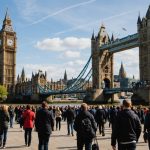Impact of London’s New Infrastructure Projects on Tourist Accessibility
London infrastructure improvements are reshaping the city’s landscape, directly boosting tourist accessibility. Major projects include transportation upgrades like expanded Underground lines and modernized stations, which reduce travel times and simplify navigation across London. Enhancements to public spaces, such as revamped plazas and pedestrian-friendly zones, also improve travel convenience by creating inviting, easy-to-access environments for visitors.
Key developments, like the Crossrail (Elizabeth Line) expansion, are either completed or in advanced stages. These projects are strategically phased to minimize disruption while maximizing benefits, ensuring tourists experience seamless transit options. For example, faster connections between airports and central London cater to international visitors aiming for swift arrivals and departures.
Also to discover : How are travel trends shifting in the UK post-pandemic?
New attractions integrated within these infrastructure plans contribute to travel convenience by clustering cultural and leisure hubs near efficient transport nodes. This design reduces the need for complicated routes and encourages exploration on foot or by public transport.
Overall, the focus on linked transport systems and enhanced public spaces transforms Tourist Accessibility in London. Visitors enjoy streamlined journeys and easier access to diverse destinations, making the city more welcoming and less daunting to navigate. Such improvements underscore the city’s commitment to a travel-friendly environment tailored for global tourists.
Also to read : What New Attractions Will Boost UK Tourism This Year?
Enhancements in Transportation and Connectivity for Visitors
Visitors to London benefit significantly from ongoing London transport upgrades, which focus on expanding and modernising the Underground, Crossrail, and bus networks. These improvements enhance the tourist transport experience by reducing travel times and increasing route options. The Crossrail project, for instance, adds new stations and faster rail links, directly connecting key tourist destinations and easing congestion on traditional lines.
Digital travel aids have transformed how tourists navigate the city. Tools like mobile apps and interactive station maps provide real-time updates and personalised route suggestions, greatly improving convenience and confidence when using public transit London options. These aids help visitors plan efficient journeys, offering clear directions and alternative routes to avoid delays.
Wayfinding has also seen major enhancements with upgraded signage and clearer station information, making it easier for tourists to find major attractions and interchange between lines without confusion. Collectively, these transport advancements directly improve travel time, boost connectivity, and streamline tourist routes, ensuring that first-time visitors and returning travellers alike can explore London’s iconic sights with ease and enjoyment.
Revitalised Public Spaces and Cultural Attractions
London’s focus on public space regeneration has transformed many areas into vibrant, pedestrian-friendly zones. This shift encourages locals and tourists alike to explore the city on foot, enhancing safety and accessibility. Revitalised parks, with upgraded landscaping and amenities, offer serene escapes amidst urban life. These green spaces invite leisurely strolls, picnics, and community events, increasing the appeal for visitors seeking relaxation and recreation.
The surge in new cultural attractions has further enriched London’s tourism landscape. Several new museums and galleries have opened, showcasing diverse art, history, and innovation. These venues not only preserve heritage but also provide dynamic spaces for exhibitions and interactive experiences. Entertainment venues have also multiplied, hosting music, theatre, and immersive performances that cater to a broad audience.
As a result, the combination of enhanced public spaces and an expanding portfolio of cultural institutions boosts tourist activities across the capital. Visitors benefit from a wide array of options, from outdoor exploration to engaging cultural immersion. This holistic approach to regeneration reflects a clear strategy: to position London as a premier global destination where every corner offers something exciting and accessible.
Effects on Accommodation and Hospitality Sector
The expansion of new infrastructure in London has notably influenced London accommodation trends. Hotels and alternative lodging options, such as boutique stays and serviced apartments, have increased capacity near these developments to meet growing demand. This growth reflects a strategic approach to capitalize on improved connectivity and accessibility, attracting visitors who prioritize convenience.
Enhanced hospitality infrastructure has also contributed significantly to visitor satisfaction. Redevelopment around transport hubs often includes upgraded public spaces, retail options, and leisure facilities, which enrich the overall guest experience. These improvements make neighbourhoods more attractive for tourists, encouraging longer stays and repeat visits.
Visitor preferences have shifted distinctly, favoring accommodations that offer quick access to key attractions and efficient transit links. Research shows that tourists increasingly select lodgings based on proximity to transport nodes and amenities rather than solely central London locations. This change underscores the importance of integrated urban planning that aligns hospitality development with infrastructure enhancements.
In summary, the synergy between infrastructure growth and London’s accommodation offerings fosters a dynamic market responsive to tourists’ evolving needs. Understanding these trends helps stakeholders optimize tourist lodging strategies and better serve the city’s diverse visitor base.
Comparison with Previous London Tourist Experiences
Examining how tourism in London has transformed over time
London tourism evolution reveals striking contrasts between historic and modern tourist experiences. Previously, travel logistics posed considerable challenges. Tourists often faced longer transit times and fewer seamless connections, making exploration cumbersome. The introduction of extensive infrastructure projects has significantly enhanced convenience, reducing travel friction and broadening accessibility across the city.
Experts note that these changes are pivotal. Urban planners and tourism analysts highlight how integrated transport systems now support fluid movement between landmarks. This shift not only enhances satisfaction but also encourages more spontaneous visits to less central attractions.
Statistical insights corroborate these observations. Visitor feedback indicates a notable increase in overall satisfaction scores since the implementation of these infrastructure enhancements. Data shows improvements in perceived ease of navigation and time efficiency, which are critical components of a positive tourist experience.
Moreover, the transition from a somewhat fragmented travel experience to a more connected and streamlined system demonstrates London’s commitment to adapting its infrastructure to meet contemporary tourism demands. This evolution has not only reshaped visitor expectations but also fostered an environment where tourists can maximize their experience with less hassle.
Understanding these distinctions informs future developments in London’s tourism strategy, aiming to maintain this positive momentum for years to come.

